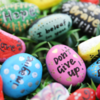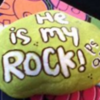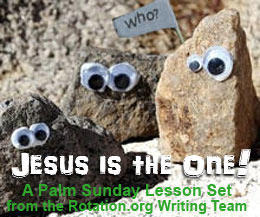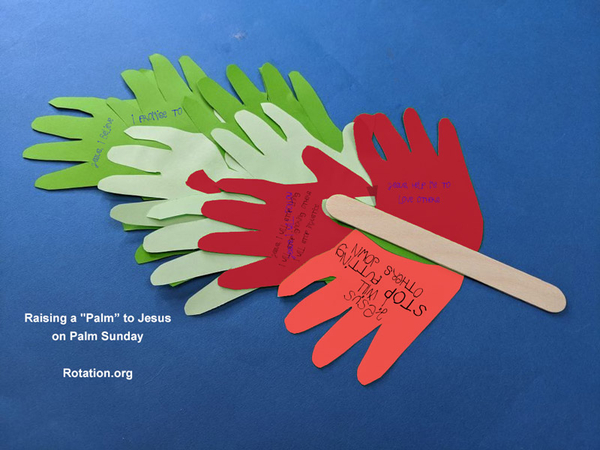Palm Sunday
"Rocks Will Sing" Art Workshop
Summary of the Lesson:
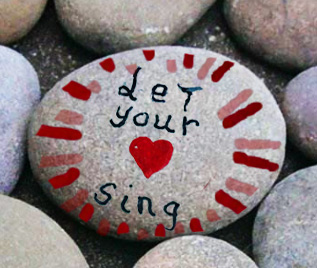 After an interactive reading of the story from Luke 19, students will paint "Hosanna" Praise Rocks as a reminder of the story and meaning of Jesus' ride into Jerusalem on Palm Sunday. They will focus on Jesus' promise that even the rocks would cry out and sing God's praise -- that God's message cannot be silenced and is meant to be shared (Luke 19:40). Students will be reminded that Jesus is deserving of our praise --- and that we praise him for the forgiveness (salvation) and unconditional message of God's love (which brings strength, comfort), and wants us to share that message with the world by being forgiving and loving.
After an interactive reading of the story from Luke 19, students will paint "Hosanna" Praise Rocks as a reminder of the story and meaning of Jesus' ride into Jerusalem on Palm Sunday. They will focus on Jesus' promise that even the rocks would cry out and sing God's praise -- that God's message cannot be silenced and is meant to be shared (Luke 19:40). Students will be reminded that Jesus is deserving of our praise --- and that we praise him for the forgiveness (salvation) and unconditional message of God's love (which brings strength, comfort), and wants us to share that message with the world by being forgiving and loving.
Rotation.org's content team has improved this lesson, adding some helpful details , suggestions, and additional life application.
Supplies: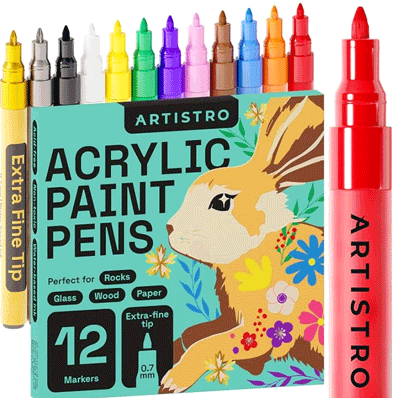
- Acrylic Paints
- Acrylic Paint Pens
- Brushes
- Paper plates for the paint dollops
- Paper Towel
- Table cloth newsprint
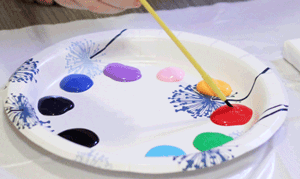 Smocks
Smocks- Permanent Markers (if desired)
- Various types of smooth stones, such as "river rock," 1 or more per student
- A fan to help dry the paint
Advanced Preparation Requirements:
- Wash the rocks and let them dry for several hours before painting.
Lesson Plan
Opening
Welcome kids to "Thou Art Studio" as they arrive. Hand out name tags and create name tags for any new students. Introduce yourself. Explain what they'll be doing today and what you hope they will learn.
Open with a prayer.
Discussion Before Reading the Story:
Ask: Has anyone here ever been to a parade? Been in a parade? Tell us about your parade experience!
Ask: What kinds of parades are there? (Holidays, but also parades celebrating a celebrity or politician)
Say: In some parades, you stand and watch the parade go by. In other parades, you join in the crowd following the band or float or person whom the parade is about. In today’s story, we are going to hear about a parade where Jesus was the main attraction, the big-time celebrity.
Ask: Why would people want to see Jesus and cheer him? What were they expecting? (accept any answer and tell them that the people were hoping he would reveal himself to be God's Messiah -- the new king of Israel who would save the people.)
Read The Story:
Instruct the children that you want them to help you tell the story so we can imagine all of the noise that the crowd was making in Jerusalem.
Whenever you say "Jesus" students should shout “the King”
Whenever you say "crowd" students should shout “hosanna”
Say "Jesus" and then, "Crowd" to help them practice, then read the following story:
THE STORY of PALM SUNDAY
As Jesus approached Jerusalem he stopped at the hill called the Mount of Olives that overlooked the city. Jesus sent two of his disciples to find a donkey. Jesus said, “Go to the village ahead of you, and as you enter it, you will find a donkey tied there, which no one has ever ridden. Untie it and bring it here. If anyone asks you, ‘Why are you untying it?’ say, ‘The Lord needs it.’”
The disciples listened to Jesus and went and found the donkey just as Jesus had told them. As they were untying the donkey, its owners asked them, "Why are you untying the donkey?”
They replied, “The Lord needs it.”
The disciples brought the donkey to Jesus. They put their cloaks on the donkey and put Jesus on it. As Jesus went along, crowds started to form. Large crowds of people welcomed Jesus with shouts of singing because of the miracles they had heard that Jesus had performed and the hope that he was going to be their new king. People in the crowds spread their cloaks on the road and palm branches from the trees as a sign of respect for Jesus.
The crowd shouted: "HOSANNA" -- which means "Save us God!" or "He has come to rescue us." And they further cheered, “Blessed is the king who comes in the name of the Lord!”
“Peace in heaven and glory in the highest!”
The crowd was loudly praising Jesus as the new king, the Messiah, but this made some religious authorities, called "Pharisees," very angry and worried. Many Pharisees didn’t believe that Jesus was the son of God, the Messiah sent by God to rescue the people, and they were mad that the crowds were praising Jesus.
So the Pharisees in the crowd said to Jesus, “Teacher, rebuke your followers! Make them stop all this noise.”
Jesus said to them “I tell you, if the crowds were to stop and keep quiet, the stones on the ground would cry out with the Good News."
So the crowds continued to praise Jesus with the hope and belief that he was the Messiah, the King sent by God. And Jesus rode into Jerusalem and immediately went to the Temple to worship God.
Discussion After the Story:
Ask:
- What kind of animal did Jesus enter into Jerusalem on? (A donkey was the sign of a humble king. What kind car might Jesus ride today in a parade that would send the same message?)
- Why were the crowds shouting and praising Jesus? (What were they hoping for?)
- What did the Pharisees say to Jesus?
- What did Jesus say to the Pharisees?
- I wonder what Jesus meant when He said that the stones on the ground would cry out in praise?
Nothing can stop God's message! Not silent crowds or angry Pharisees. Even if you think you are like a rock, kind of dense and hard and not so special, God can turn you into a voice for his love and forgiveness.
Tip: As you say this last part, pick up a rock and tap it on the table and then to the side of your head.
Praise Rocks Activity
Explain to students how they will be making praise rocks.
First they need to choose and paint a message,
then they can decorate their rock a little more if they'd like.
Ask: What are some possible "messages" about Jesus that God wants us to share? ...Messages you might shout to Jesus if you were following him in a parade and wanted the crowd to hear.
As you get responses, write them on the board and condense them so that they are easy to fit on rocks.
Here are a few suggestions:
Forgiven/Forgive
Loved/Love
Make Peace
Let Your Heart Sing
Jesus King (crown symbol)
Heart of Worship
Hosanna!
God Saves
Sing Praises
Praise God
Jesus Rocks!
Follow the King
As they complete their rock, invite them to create an "encouragement rock" that can be shared with someone. Encouragement Rocks can be simple biblical reminders, like "Be Kind," "Do Good," Love Others," "Honor God," "Live Joyfully."
Painting Setup:
- Use the paint "pens" for the messages.
- Use any paint "brushes" for the decorating of the rest of the rock.
- Caution them about using too much paint (it can smear and take too long to dry).
- Provide a paper plate palette of paint for every 2-3 students. Pre-squeeze several choices of colors onto each pallet. Children can request different colors if needed.
- Remind them to use one brush per color and not mix between colors. Share the brushes.
- Remind students that they don’t want to make the paint too thick or it will take a long time to dry.
- While students are working:
- Encourage students by complimenting their work!
- Some students may need extra help. Be on the lookout for students who are needing a hand or more instruction!
- Talk about what a treat it is to praise Jesus!
- Ask students what they think a rock would sound like if it started to praise Jesus.
- Be on the lookout for spills and keep paper towel handy. Clean up spills quickly to avoid bigger messes.
- After they are done with their rock, have them write their name on a piece of paper and place it under the rock, and then put the rock in front of a fan for quicker drying.
- Cleanup.
Closing Reflection:
Gather students around the rocks as they are drying. Have them read their rock's message and reinforce its message as they do. Discuss a few places they could display their rock so that it's message would be seen by others and encourage them to think about Jesus.
Close with a prayer that God would use us like these rocks to share the message with others that Jesus our Messiah is here with God's message of forgiveness and love.
What is our "THOU ART! STUDIO" ?
“Thou Art! Studio” is our "Art Workshop" in our Rotation Model Sunday School where children can use their creativity and tactile learning abilities to understand God's word in unique ways. Children use a variety of art forms to experience worship, explore stories and express Biblical truths.
A lesson originally written by ZBCC from: Zion Baptist Community Church
Edmonton, Alberta. Updated by a member of the Rotation.org Content Team.
Rotation.org is the largest curated and creative source of free Sunday School lessons, ideas, and resources on the web today. Become a Supporting Member!

 Summary of Lesson Activities:
Summary of Lesson Activities: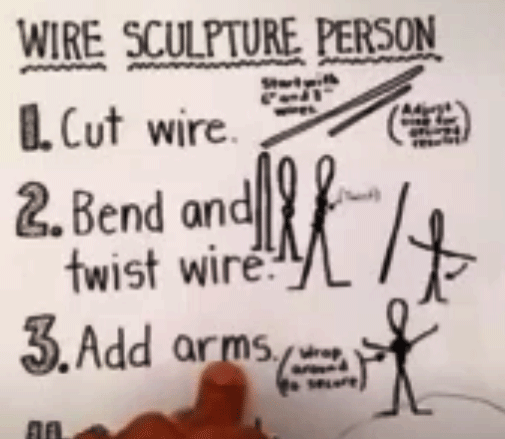
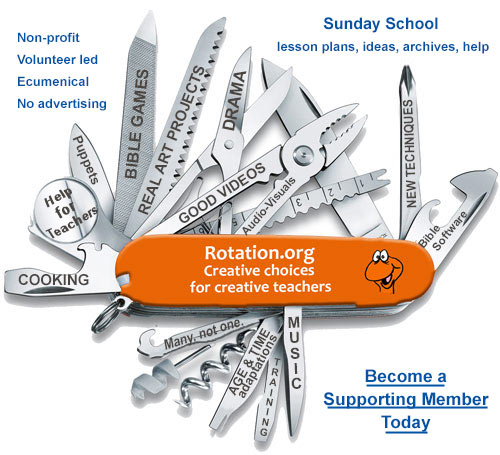



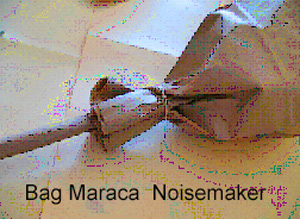
 The full lesson is attached to this post as a Word doc that you can modify. It includes pictures that illustrate the projects and "teaching comments" to share during the activities. Linked below are two companion lessons that go with this Rotation-style lesson -- Science and Storytelling Workshops.
The full lesson is attached to this post as a Word doc that you can modify. It includes pictures that illustrate the projects and "teaching comments" to share during the activities. Linked below are two companion lessons that go with this Rotation-style lesson -- Science and Storytelling Workshops.



 Smocks
Smocks

